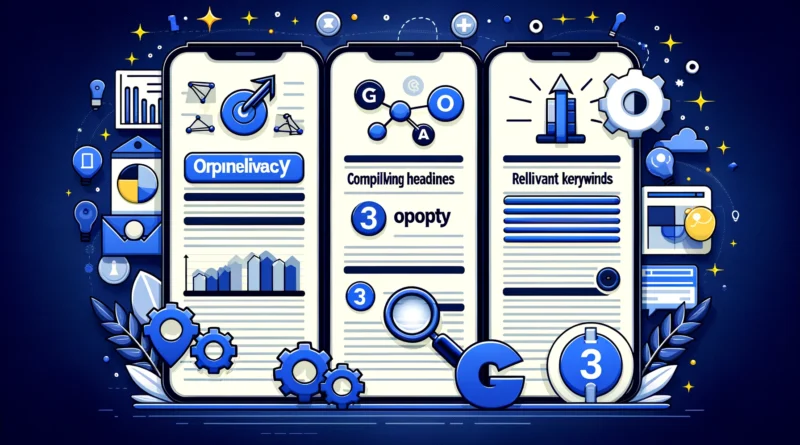3 Ways to Optimize Your Google Ad Copy
Creating effective Google Ads is crucial for driving traffic and conversions. Optimizing your ad copy can significantly impact your ad performance, helping you reach your target audience more efficiently and achieve better results. Here are three essential ways to optimize your Google Ad copy.
1. Use Compelling Headlines
Grab Attention Quickly
Your headline is the first thing users see, and it plays a critical role in capturing their attention. A compelling headline should be clear, concise, and relevant to the search query.
- Highlight Benefits: Focus on the benefits of your product or service rather than just features. For example, instead of “High-Quality Shoes,” try “Comfortable Shoes for All-Day Wear.”
- Include Keywords: Incorporate relevant keywords in your headline to ensure that it resonates with the user’s search intent and improves your ad’s relevance score.
Create a Sense of Urgency
Creating a sense of urgency in your headline can encourage users to take immediate action. Use words like “limited time,” “exclusive,” or “today only” to prompt quick responses.
- Offer Time-Sensitive Deals: Phrases like “50% off this week only” can compel users to click on your ad.
- Use Action Words: Action-oriented words like “get,” “buy,” or “discover” can motivate users to click on your ad.
Test Different Variations
A/B testing different headline variations can help you determine which one performs best. Experiment with different wording, lengths, and calls to action to find the most effective combination.
- Try Different Angles: Test various approaches, such as focusing on benefits, features, or emotions.
- Measure Performance: Use metrics like click-through rate (CTR) to evaluate the effectiveness of each headline.
2. Focus on Relevance and Keyword Integration
Align Ad Copy with Search Intent
Ensure that your ad copy is relevant to the user’s search query and matches their intent. This increases the likelihood of your ad being clicked and improves your quality score.
- Understand User Intent: Identify the intent behind the keywords you are targeting, whether it’s informational, navigational, or transactional.
- Match Keywords: Use the same or similar keywords in your ad copy that are being used in the search queries to ensure alignment.
Use Long-Tail Keywords
Long-tail keywords are more specific and less competitive, making it easier to target niche audiences and improve ad relevance.
- Target Specific Phrases: Use long-tail keywords that closely match the user’s search intent. For example, instead of “shoes,” use “women’s running shoes.”
- Include Variations: Incorporate different variations of your keywords to cover a broader range of search queries.
Optimize for Mobile
With the increasing number of users accessing the internet via mobile devices, optimizing your ad copy for mobile is essential. Ensure that your ad is concise and easy to read on smaller screens.
- Short and Impactful: Keep your ad copy short and impactful to ensure it displays well on mobile devices.
- Mobile-Friendly Calls to Action: Use CTAs that are easy to interact with on mobile, such as “Tap to Call” or “Find a Store Near You.”
3. Include Strong Calls to Action (CTAs)
Direct and Clear CTAs
A strong call to action is essential for guiding users towards the desired action, whether it’s making a purchase, signing up for a newsletter, or contacting your business.
- Be Specific: Use clear and specific CTAs like “Shop Now,” “Learn More,” or “Get a Free Quote.”
- Highlight Value: Emphasize the value or benefit of taking action, such as “Save 20% Today” or “Download Free Guide.”
Test Different CTAs
Experimenting with different CTAs can help you identify which ones resonate most with your audience and drive the desired actions.
- Try Various Phrases: Test different phrases to see which ones encourage the most clicks and conversions.
- Monitor Results: Analyze the performance of each CTA using metrics like conversion rate and CTR to determine the most effective options.
Match CTAs with Landing Pages
Ensure that your CTA aligns with the content and goals of your landing page. A consistent message from the ad to the landing page can enhance user experience and increase conversions.
- Consistency is Key: If your ad promises a discount, make sure the landing page clearly shows the discount and how to redeem it.
- Reinforce Action: Reinforce the CTA on your landing page to guide users through the conversion process.
Conclusion
Optimizing your Google Ad copy is essential for improving your ad performance and achieving better results in your PPC campaigns. By using compelling headlines, focusing on relevance and keyword integration, and including strong calls to action, you can create ads that capture attention, drive clicks, and boost conversions. Implement these tips to enhance your Google Ad strategy and achieve greater success in your digital marketing efforts.
